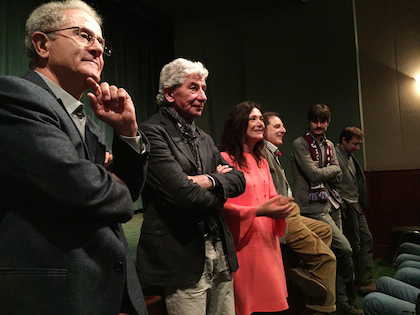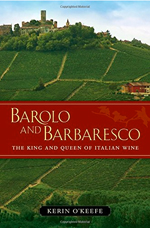Barolo in the spotlight: Barolo Boys and Barolo & Barbaresco

Some of the protagonists of “Barolo Boys” (L to R): Elio Altare, Domenico Clerico, Chiara Boschis, Marco de Grazia.
In 1983, a chainsaw echoed across the hills of the Barolo region. No humans were harmed in this Barolo massacre: Elio Altare took a chainsaw into the cellar of his family’s winery and cut up the large botti, or large wooden casks, often leaky and fetid, that his father used. He brought in barriques, the small wooden barrels more frequently seen at that time in Burgundy or Bordeaux. His father subsequently disinherited him.
This dramatic rupture with the past is captured in the pages of Barolo and Barbaresco, the essential and timely new book by Kerin O’Keefe. The chainsaw-wielding is also depicted on-screen in the new Italian documentary about the region, Barolo Boys.
The movie, screened for the first time in New York City on Monday, portrays the events of Altare and others as they ushered in a “revolution” to Barolo’s winemaking. A “war” broke out between the “modernists” and the “traditionalists.” This young Turks threw out the old casks, brought in barriques, but also started green harvesting in the vineyard, the process of dropping bunches of grapes to concentrate flavor in the remaining ones. The resulting wines were darker and denser but also flashier, fruitier with more obvious polish and immediate appeal than pure charm of nebbiolo, which is notorious for needing decades in the cellar to coax out.
If wanting to make wines more hygienically was a big push–Altare’s daughter talks in the film about how farm animals and a leaky oil-furnace shared the cellars with the wines–these wines also needed the pull of a commercial outlet. And the film makes clear this was the United States, where critics and consumers lavished praise on the new style and opened their pocketbooks for the wines imported by Marco de Grazia, among others.
While the stylistic clash was heated for a while, it has largely been relegated to the compost pile of history: many of the “modernists” now use larger formats than just barriques, incorporating both new and used barrels, while some of the “traditionalists” do things such as green harvesting, even if they remain steadfast in their use of botti or other larger format vessels for aging. In a discussion after the screening, the protagonists present agreed that the conflict was good for getting increasing interest in the area’s wines.
Elio Altare cast the rift in a different way in comments after the screening, “There are two types of wine: good and bad.” There was an outburst of applause in the room. He continued, “It’s personal taste. I must find the people in the world who drink wine with my taste. I don’t make wine for everybody: I make wine for my taste!” This slightly defiant tone paled in comparison to Joe Bastianich, the film’s narrator, whose last words are “the fight goes on.” The director said he took some liberties with that line and was intended to reprise the “journey” that he invited viewers on in the film’s opening segment.
 Kerin O’Keefe provides much more texture in Barolo and Barbaresco. She provides more history, pointing to Angelo Gaja’s pioneering use of barrels in the Barbaresco region, adjacent to Barolo. She offers a more nuanced discussion of the contentious debates between modernists (now, a “ridiculously outdated” term she argues) and traditionalists that incorporates more points of view and more characters than the film. She also notes that not only did media outlets such as Wine Spectator praise the modern style, but they laid waste to some traditionalists, including giving the 1989 Barolo from Bartolo Mascarello a “lowly and insulting 76 points” and the 1989 Bruno Giacosa Barolo Collina Rionda “a miserly and misplaced 78 points.” She also brings up the “taboo” subject of whether, for a time, the modernist wines achieved their dark color through illicit blending of cabernet though her discussion provides no conclusive evidence.
Kerin O’Keefe provides much more texture in Barolo and Barbaresco. She provides more history, pointing to Angelo Gaja’s pioneering use of barrels in the Barbaresco region, adjacent to Barolo. She offers a more nuanced discussion of the contentious debates between modernists (now, a “ridiculously outdated” term she argues) and traditionalists that incorporates more points of view and more characters than the film. She also notes that not only did media outlets such as Wine Spectator praise the modern style, but they laid waste to some traditionalists, including giving the 1989 Barolo from Bartolo Mascarello a “lowly and insulting 76 points” and the 1989 Bruno Giacosa Barolo Collina Rionda “a miserly and misplaced 78 points.” She also brings up the “taboo” subject of whether, for a time, the modernist wines achieved their dark color through illicit blending of cabernet though her discussion provides no conclusive evidence.
After the opening discussion in the book, O’Keefe provides detailed producer profiles, which are extremely useful not only for the discussion of the house styles and personalities involved, some tasting notes, maps, and also the contact information of the producers. In a trip to Barolo earlier this year, I had an almost impossible time finding some addresses (hint: try searching google.it) let alone email addresses so this will be particularly useful to travelers.
Barolo has gotten a lot more popular in recent years. And, with rising prices in many other fine wine regions, consumers and collectors around the world may increasingly develop a love affair with nebbiolo. So use these tools to get a lay of the land and the debates. See the movie. Read the book. Pull some corks. And start plotting an itinerary for a visit to the region.
Barolo and Barbaresco: The King and Queen of Italian Wine, by Kerin O’Keefe
There will also be a free public screening at NYU on Thursday at 6PM. Discussion with Elio Altare and others to follow.




On November 7th, 2014 at 10:11 am ,Gary York wrote:
You are far too easy on the book. It is a good book, but you could have offered some balanced views.
On November 7th, 2014 at 12:13 pm ,Alison wrote:
Good job, it was an excellent idea to review the movie and the book side by side. I just finished the book and loved it, but I have not seen the movie yet, I just ordered it.
On November 7th, 2014 at 2:04 pm ,Ian Sutton wrote:
Contact details are comprehensive and kept up to date at the excellent langhe & roero tourist office site http://www.langheroero.it
Email addresses only appear to be an issue for the most prestigious half dozen wineries.
On November 7th, 2014 at 2:54 pm ,James Young wrote:
Well done, ordered the movie and the book. I loved her Brunello di Montalcino book but I was not aware of this new book on Barolo and Barbaresco
On November 11th, 2014 at 5:05 pm ,Wine News 4-11 November | winetuned wrote:
[…] And finally, Dr. Vino posted about both Kerin O’Keefe’s new book, Barolo and Barbaresco, and the Italian …. […]